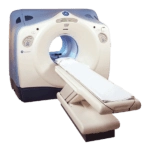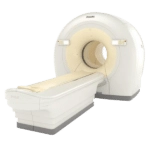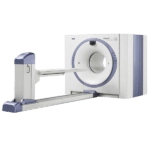PET/CT machines collect data from both in one scan session combined in a single gantry system
The PET-CT scanner, or Positron emission tomography-computed tomography, is a combination of the PET scanner and the CT scanner. The concept collects data from both the PET and CT scanners in one scan session combined in a single gantry system (the gantry is the ring the patient is inserted in), in order to produce a single superposed image. This is useful since PET scans are best for the spatial distribution of metabolic or biochemical activity in the body, and CT scans are best for anatomical imaging. This is because PET scans can display changes in processes at a cellular level, whereas a CT scan reveals glimpses at tissues and organs.
The PET scanner was introduced in the early 1960’s, and the CT scanner in the early 1970’s. It wasn’t until the 90’s, however, that the idea to combine the two for even better image quality was considered. Until the invention of the PET-CT, medical doctors were frustrated for years, attempting to match two different scans from the PET or CT scanners and studying them in order to determine the exact location of a tumor, for example.
How did the solution develop? The idea for the PET-CT scanner came about from an earlier low-cost PET scanner. It comprised rotating banks of bismuth germinate (BGO) block detectors that were developed by David W. Townsend at the University of Geneva in 1991. There were gaps between the banks of the BGO detectors, which offered the possibility to incorporate a different imaging modality within the PET scanner. It was then that Swiss oncology surgeon Dr. Rudi Egeli suggested that they add the CT scanner in the gaps in order to provide more anatomical information that was familiar to surgeons.
Dr. Townsend moved to the University of Pittsburgh in 1993 in order to work with Dr. Ron Nutt, who was then the president of CTI PET systems in Knoxville, Tennessee. They received NIH funding in order to complete the PET-CT prototype, but it wasn’t until seven years later that the first prototype PET-CT scanner was completed and installed at the University of Pittsburgh Medical Center.
The first commercial PET-CT scanner to be announced was the GE Discovery LS in 2001. It incorporated a 4-slice CT scanner, which, at the time, was the highest end CT available in terms of the number of detector rows. Modern CT scanners go all the way up to 320 slices.
Get Started
Request Pricing Today!
We’re here to help! Simply fill out the form to tell us a bit about your project. We’ll contact you to set up a conversation so we can discuss how we can best meet your needs. Thank you for considering us!
Great support & services
Save time and energy
Peace of mind
Risk reduction
Dr. Townsend and Dr. Nutt would be highlighted by Time magazine in 2000, when Time named the PET-CT scanner the Medical Invention of the Year.
Currently, manufacturers that offer PET-CT scanners include: GE, Hitachi, Philips, Toshiba, Siemens, Mediso, MinFound, and MiE.
CT scanners and PET scanners are triumphs of the medical community in their own right, but when you put the two together, you get something even more special: the missing piece to a puzzle that baffled the medical community for years. Luckily, we have Dr. Townsend and Dr. Nutt to thank for their incredible contribution to the medical world.
If you have any questions about PET-CT scanners, give us a call and check out our website here. At Amber Diagnostics we’ve proudly served the healthcare community for over 25 years, so we’d be happy to answer any questions you may have. Please take a look at our range of PET-CT equipment and don’t hesitate to reach out.
Reference: Combined PET/CT: the historical perspective



